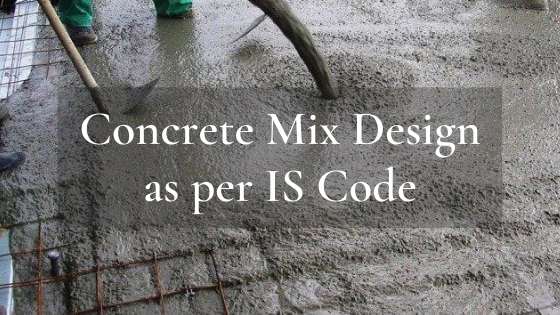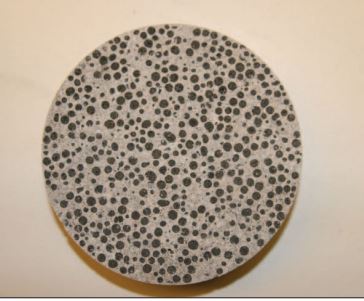Concrete is a heterogeneous and hardened mass obtained from a mixture of cement, sand, coarse aggregate and water, in a certain proportion.
The grade of concrete varies greatly in accordance with the changing proportion of its constituent materials. The proportion and the ratio, in which the materials should be mixed together to obtain a certain grade of the concrete, has already been specified by IS 456:2000.
But the limitation of the code is, that it specifies the ratios of the materials, up to a certain grade, which is M25, beyond which, no certain proportion has been industrially approved.
| S.No | Grade | Proportion (cement: sand: coarse aggregate) |
|---|---|---|
| 1 | M5 | 1:5:10 |
| 2 | M7.5 | 1:4:8 |
| 3 | M10 | 1:3:6 |
| 4 | M15 | 1:2:4 |
| 5 | M20 | 1:1.5:3 |
| 6 | M25 | 1:1:2 |
These are called Nominal Mix.
In the era of industrial and infrastructural developments, to cater the need for high strength concrete and overall improvement of the concrete properties, various high strength concrete has been introduced, taking it way more than M100.
Due to the limitation of IS:456, a new procedure have been adopted in all around India, which is to properly design the mix, from the scratch, and thus finding the required ratio for that particular Concrete.
This is known as Mix Design of Concrete, which follows some certain principles, devised by IS:10262,2009. In this article, I’d like to mention some useful notes on designing the mix, as well as factors dependent on mix design, as a clear understanding of mix design processes is what a civil engineering firm expect from a fresher.
Factors Dependent on Mix Design:
While Designing a concrete mix, there is a wide range of factors, involved throughout the process, which largely contributes to the end product, which is Concrete and all of its properties. So considering all of these factors, and carefully maintaining it to it’s desired level, would add significant value to the quality and strength of the concrete. Some of these factors have been mentioned following-
- Grade of Cement
- Size and shape of aggregates
- Grading Zone of Aggregate
- Water absorption by the aggregate
- The specific gravity of the materials
- Type of Admixture added
- Slump value of the concrete
- W/C Ratio of concrete
- Degree of supervision provided
- Method of transportation of concrete
- Concreting Methods(such as Tremie or underwater concreting).
Concrete Mix Design Procedure:
The concrete mix is designed while taking into consideration the above factors. After properly designing the structure by a structural designer, the concrete technologists stipulate certain minimum strength of the concrete, that should be used in casting the structural members. After that, the site engineer prepares the concrete at site, by closely following the parameters, which overall contributes to the long term durability and strength of the concrete. So a properly designed mix is very much needed for the structure to safely withstand all the loads which are expected to act on it, during its lifespan.
1. Target Mean Strength:
Before designing concrete Mix, the grade of the concrete, for which the design will be performed, should always be known beforehand. That is known as a characteristic strength of the concrete (in M45 concrete, the characteristic strength of the concrete is 45Mpa). From the characteristic strength, the target mean strength is found out, for that specific concrete, from the given formulae-
Target Mean Strength = Characteristic strength + t x s
Where, t is the tolerance factor which is equal to 1.65, taking 5% of the test results are expected to fall below it
And s is the standard deviation whose value can be found out of a separate grade of concrete, from “Standard Deviation chart” from any concrete book.
2. Water-Cement Ratio:
After the Target Mean Strength has been found out, the water-cement ratio is being determined, either using the chart specified by IS:456,2000 on the basis of the Exposure condition and Grade of concrete or by using some experience used for the similar construction executed recently. W/C Ratio is one of the most important factors of the concrete, which controls overall quality, as well as have a direct or indirect effect on different properties of concrete.
3. Water Content Determination:
After the W/C ratio has been determined, the amount of water required for mixing that specific grade of concrete may be found out through a chart, which is based on the size of aggregates used for making that concrete.
- For 10 mm aggregates: 208 kg
- 20 mm aggregates: 186 kg
- 40 mm aggregates: 165kg
The above value Is for the aggregates of angular course type and slumps range of 25-50mm. For different shapes of aggregates, as well as for slump ranges, the water content can be adjusted proportionately.
The amount of water content can be reduced by 10 kg for sub-angular aggregates, 20 kg for gravel and 25 kg for rounded gravel. The water content can also be adjusted depending upon the slump value. For every 25 mm increased slump, the water content can be increased by an amount equal to 3 per cent.
4. Cement Content Determination:
After the required water content is determined, then from the water-cement ratio, and obtained water content, the cement content can easily be found out.
W/C Ratio = Water Content/Cement Content
5. Determining the amount of Course and fine aggregates:
The coarse and fine aggregates are then Determined. The weight of the coarse aggregate depends upon the size of the course Aggregates used and grading zones of the aggregate, namely, there are four grading zones of the aggregates, I, II, III and IV. The value can be found out from the respective charts in the” Design Mix” chapter of any concrete book. The value obtained from the chart is the volume of the coarse aggregate, per unit volume of total aggregates. After, the volume of the fine aggregates is found out by deducting the volume of course aggregate, from number 1.
6. Determination of Total volume of all the materials:
The volume of all the materials can be obtained from the following formulae-
Volume= Weight obtained/specific gravity× 1/1000
If Admixture is used, then the volume of Admixture is also being determined. It can be determined by the following formulae-
Volume= dosage of Admixture× Cement content× 1/1000
Considering the total volume of concrete produced as 1 cubic metre, the volume of cement, water, and Admixtures are determined. Then the remaining value is the volume of the total aggregates. By multiplying the volume of the total aggregates with the volume of the coarse and fine aggregates per unit volume of the aggregate, specific gravity of respective aggregates and the value 1000.
7. Taking out the ratio:
After the volume and weight of all the materials are found out, then the ratio of the respective materials are determined. It is generally done by making the value of the cement as 1 and dividing all the weight of elements by the weight of cement.
8. Preparation of trial mixes:
Generally, four trial mixes are prepared to check the desired strength and all other properties. The second trial mix is done by constant w/c ratio of the first one, and varying water/Admixture content. Trial mix 3 and 4 is done by keeping the water content as preselected value and varying W/C ratio by 10 per cent.
These are the eight steps involved in the calculation of Mix Design. I would recommend seeing an example of Design Mix from any concrete book, as an example would be very helpful in remembering these points as well as properly understanding them. A properly designed concrete mix offers around improvement of various characteristics, which not only resists all the loads expected on that concrete, it also offers greater stability throughout its lifespan as well as beyond the lifespan.



Really informative…Thanks❤
Better knowledge for understanding about concrete mix design
Great information about concrete mix design with codes. Thanks
CIVIL
R M C
Thank you for this topic as it helps me to understand clearly about concrete mix design. Keep it up.